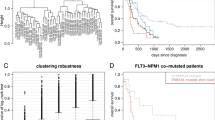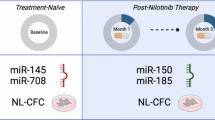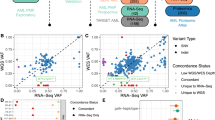Abstract
Acute myeloid leukemia (AML) is a highly heterogeneous disease, characterized by various cytogenetic and molecular abnormalities, many of which may express prognostic value. MicroRNAs (miRNAs) are a class of small regulatory RNAs. The prognostic value of miRNAs in AML is yet to be determined. Here, we set out to identify miRNAs that are consistent significant prognostic determinants, independent from other known prognostic factors. A discovery cohort (n=167) and validation cohort (n=409) of a heterogeneous AML population were used to reliably identify miRNAs with prognostic value. We report miR-212 as an independent prognostic factor, significantly associated with a prolonged overall survival (OS) and also event-free and relapse-free survival in a discovery cohort (hazard ratio (HR)s=0.77, P=0.015 for OS) that was subsequently confirmed in an independent validation cohort of 409 cases (HR=0.83, P=0.016). The prognostic significance and the prevalence of high miR-212 did not correlate with specific (cyto)genetic subtypes of AML. High miR-212 expression levels are associated with a gene expression profile that is significantly enriched for genes involved in the immune response. MiR-212 may improve the current prognostic risk stratification of mixed AML including normal karyotype AML and AML with cytogenetic and molecular abnormalities.
This is a preview of subscription content, access via your institution
Access options
Subscribe to this journal
Receive 12 print issues and online access
$259.00 per year
only $21.58 per issue
Buy this article
- Purchase on Springer Link
- Instant access to full article PDF
Prices may be subject to local taxes which are calculated during checkout


Similar content being viewed by others
Accession codes
References
Dohner H, Estey EH, Amadori S, Appelbaum FR, Buchner T, Burnett AK et al. Diagnosis and management of acute myeloid leukemia in adults: recommendations from an international expert panel, on behalf of the European LeukemiaNet. Blood 2010; 115: 453–474.
Rowley JD . Identificaton of a translocation with quinacrine fluorescence in a patient with acute leukemia. Annales de genetique 1973; 16: 109–112.
Mrozek K, Prior TW, Edwards C, Marcucci G, Carroll AJ, Snyder PJ et al. Comparison of cytogenetic and molecular genetic detection of t(8;21) and inv(16) in a prospective series of adults with de novo acute myeloid leukemia: a Cancer and Leukemia Group B Study. J Clin Oncol 2001; 19: 2482–2492.
Arthur DC, Bloomfield CD . Association of partial deletion of the long arm of chromosome 16 and bone marrow eosinophilia in acute non-lymphocytic leukemia. Blood 1983; 62: 931.
Ziemin-van der Poel S, McCabe NR, Gill HJ, Espinosa R, Patel Y, Harden A et al. Identification of a gene, MLL, that spans the breakpoint in 11q23 translocations associated with human leukemias. Proc Natl Acad SciUSA 1991; 88: 10735–10739.
Dohner K, Schlenk RF, Habdank M, Scholl C, Rucker FG, Corbacioglu A et al. Mutant nucleophosmin (NPM1) predicts favorable prognosis in younger adults with acute myeloid leukemia and normal cytogenetics: interaction with other gene mutations. Blood 2005; 106: 3740–3746.
Verhaak RG, Goudswaard CS, van Putten W, Bijl MA, Sanders MA, Hugens W et al. Mutations in nucleophosmin (NPM1) in acute myeloid leukemia (AML): association with other gene abnormalities and previously established gene expression signatures and their favorable prognostic significance. Blood 2005; 106: 3747–3754.
Green CL, Koo KK, Hills RK, Burnett AK, Linch DC, Gale RE . Prognostic significance of CEBPA mutations in a large cohort of younger adult patients with acute myeloid leukemia: impact of double CEBPA mutations and the interaction with FLT3 and NPM1 mutations. J Clin Oncol 2010; 28: 2739–2747.
Taskesen E, Bullinger L, Corbacioglu A, Sanders MA, Erpelinck CA, Wouters BJ et al. Prognostic impact, concurrent genetic mutations, and gene expression features of AML with CEBPA mutations in a cohort of 1182 cytogenetically normal AML patients: further evidence for CEBPA double mutant AML as a distinctive disease entity. Blood 2011; 117: 2469–2475.
Nakao M, Yokota S, Iwai T, Kaneko H, Horiike S, Kashima K et al. Internal tandem duplication of the FLT3 gene found in acute myeloid leukemia. Leukemia 1996; 10: 1911–1918.
Thol F, Damm F, Ludeking A, Winschel C, Wagner K, Morganzzz M et al. Incidence and prognostic influence of DNMT3A mutations in acute myeloid leukemia. J Clin Oncol 2011; 29: 2889–2896.
Ley TJ, Ding L, Walter MJ, McLellan MD, Lamprecht T, Larson DE et al. DNMT3A mutations in acute myeloid leukemia. N Engl J Med 2010; 363: 2424–2433.
Yan XJ, Xu J, Gu ZH, Pan CM, Lu G, Shen Y et al. Exome sequencing identifies somatic mutations of DNA methyltransferase gene DNMT3A in acute monocytic leukemia. Nat Genet 2011; 43: 309–315.
Groschel S, Lugthart S, Schlenk RF, Valk PJ, Eiwen K, Goudswaard C et al. High EVI1 expression predicts outcome in younger adult patients with acute myeloid leukemia and is associated with distinct cytogenetic abnormalities. J Clin Oncol 2010; 28: 2101–2107.
Langer C, Radmacher MD, Ruppert AS, Whitman SP, Paschka P, Mrozek K et al. High BAALC expression associates with other molecular prognostic markers, poor outcome, and a distinct gene-expression signature in cytogenetically normal patients younger than 60 years with acute myeloid leukemia: a Cancer and Leukemia Group B (CALGB) study. Blood 2008; 111: 5371–5379.
Langer C, Marcucci G, Holland KB, Radmacher MD, Maharry K, Paschka P et al. Prognostic importance of MN1 transcript levels, and biologic insights from MN1-associated gene and microRNA expression signatures in cytogenetically normal acute myeloid leukemia: a cancer and leukemia group B study. J Clin Oncol 2009; 27: 3198–3204.
Marcucci G, Maharry K, Whitman SP, Vukosavljevic T, Paschka P, Langer C et al. High expression levels of the ETS-related gene, ERG, predict adverse outcome and improve molecular risk-based classification of cytogenetically normal acute myeloid leukemia: a Cancer and Leukemia Group B Study. J Clin Oncol 2007; 25: 3337–3343.
Rockova V, Abbas S, Wouters BJ, Erpelinck CA, Beverloo HB, Delwel R et al. Risk stratification of intermediate-risk acute myeloid leukemia: integrative analysis of a multitude of gene mutation and gene expression markers. Blood 2011; 118: 1069–1076.
Bartel DP . MicroRNAs: genomics, biogenesis, mechanism, and function. Cell 2004; 116: 281–297.
Havelange V, Garzon R . MicroRNAs: emerging key regulators of hematopoiesis. Am J Hematol 2010; 85: 935–942.
Garzon R, Garofalo M, Martelli MP, Briesewitz R, Wang L, Fernandez-Cymering C et al. Distinctive microRNA signature of acute myeloid leukemia bearing cytoplasmic mutated nucleophosmin. Proc Natl Acad Sci USA 2008; 105: 3945–3950.
Jongen-Lavrencic M, Sun SM, Dijkstra MK, Valk PJ, Lowenberg B . MicroRNA expression profiling in relation to the genetic heterogeneity of acute myeloid leukemia. Blood 2008; 111: 5078–5085.
Marcucci G, Radmacher MD, Maharry K, Mrozek K, Ruppert AS, Paschka P et al. MicroRNA expression in cytogenetically normal acute myeloid leukemia. N Engl J Med 2008; 358: 1919–1928.
Bousquet M, Quelen C, Rosati R, Mansat-De Mas V, La Starza R, Bastard C et al. Myeloid cell differentiation arrest by miR-125b-1 in myelodysplastic syndrome and acute myeloid leukemia with the t(2;11)(p21;q23) translocation. J Exp Med 2008; 205: 2499–2506.
Garzon R, Heaphy CE, Havelange V, Fabbri M, Volinia S, Tsao T et al. MicroRNA 29b functions in acute myeloid leukemia. Blood 2009; 114: 5331–5341.
Popovic R, Riesbeck LE, Velu CS, Chaubey A, Zhang J, Achille NJ et al. Regulation of mir-196b by MLL and its overexpression by MLL fusions contributes to immortalization. Blood 2009; 113: 3314–3322.
Russ AC, Sander S, Luck SC, Lang KM, Bauer M, Rucker FG et al. Integrative nucleophosmin mutation-associated microRNA and gene expression pattern analysis identifies novel microRNA - target gene interactions in acute myeloid leukemia. Haematologica 2011; 96: 1783–1791.
Schwind S, Maharry K, Radmacher MD, Mrozek K, Holland KB, Margeson D et al. Prognostic significance of expression of a single microRNA, miR-181a, in cytogenetically normal acute myeloid leukemia: a Cancer and Leukemia Group B study. J Clin Oncol 2010; 28: 5257–5264.
Schlenk RF, Dohner K, Mack S, Stoppel M, Kiraly F, Gotze K et al. Prospective evaluation of allogeneic hematopoietic stem-cell transplantation from matched related and matched unrelated donors in younger adults with high-risk acute myeloid leukemia: German-Austrian trial AMLHD98A. J Clin Oncol 2010; 28: 4642–4648.
Verhaak RG, Wouters BJ, Erpelinck CA, Abbas S, Beverloo HB, Lugthart S et al. Prediction of molecular subtypes in acute myeloid leukemia based on gene expression profiling. Haematologica 2009; 94: 131–134.
Schlenk RF, Dohner K, Krauter J, Frohling S, Corbacioglu A, Bullinger L et al. Mutations and treatment outcome in cytogenetically normal acute myeloid leukemia. N Engl J Med 2008; 358: 1909–1918.
Sun SM, Dijkstra MK, Bijkerk AC, Brooimans RA, Valk PJ, Erkeland SJ et al. Transition of highly specific microRNA expression patterns in association with discrete maturation stages of human granulopoiesis. Br J Haematol 2011; 155: 395–398.
Corthals SL, Sun SM, Kuiper R, de Knegt Y, Broyl A, van der Holt B et al. MicroRNA signatures characterize multiple myeloma patients. Leukemia 2011; 25: 1784–1789.
Merkerova M, Vasikova A, Belickova M, Bruchova H . MicroRNA expression profiles in umbilical cord blood cell lineages. Stem Cells Dev 2010; 19: 17–26.
Livak KJ, Schmittgen TD . Analysis of relative gene expression data using real-time quantitative PCR and the 2(-Delta Delta C(T)) Method. Methods 2001; 25: 402–408.
Bruserud O, Ryningen A, Olsnes AM, Stordrange L, Oyan AM, Kalland KH et al. Subclassification of patients with acute myelogenous leukemia based on chemokine responsiveness and constitutive chemokine release by their leukemic cells. Haematologica 2007; 92: 332–341.
Maghazachi AA . Role of chemokines in the biology of natural killer cells. Curr Top Microbiol Immunol 2010; 341: 37–58.
Kittan NA, Hildebrandt GC . The chemokine system: a possible therapeutic target in acute graft versus host disease. Curr Top Microbiol Immunol 2010; 341: 97–120.
Costello RT, Mallet F, Chambost H, Sainty D, Arnoulet C, Gastaut JA et al. Acute myeloid leukaemia triggering via CD40 induces leukocyte chemoattraction and cytotoxicity against allogenic or autologous leukemic targets. Leukemia 2000; 14: 123–128.
Atfy M, Eissa M, Salah HE, El Shabrawy DA . Role of urokinase plasminogen activator receptor (CD87) as a prognostic marker in acute myeloid leukemia. Med Oncol (Northwood, London, England); e-pub ahead of print 3 June 2011; doi:10.1007/s12032-011-9993-x.
Park JK, Henry JC, Jiang J, Esau C, Gusev Y, Lerner MR et al. miR-132 and miR-212 are increased in pancreatic cancer and target the retinoblastoma tumor suppressor. Biochem Biophys Res Commun 2011; 406: 518–523.
Im HI, Hollander JA, Bali P, Kenny PJ . MeCP2 controls BDNF expression and cocaine intake through homeostatic interactions with microRNA-212. Nat Neurosci 2010; 13: 1120–1127.
Wada R, Akiyama Y, Hashimoto Y, Fukamachi H, Yuasa Y . miR-212 is downregulated and suppresses methyl-CpG-binding protein MeCP2 in human gastric cancer. Int J Cancer 2010; 127: 1106–1114.
Xu L, Wang F, Xu XF, Mo WH, Xia YJ, Wan R et al. Down-regulation of miR-212 expression by DNA hypermethylation in human gastric cancer cells. Med Oncol (Northwood, London, England) 2011; 28 (Suppl 1): S189–S196.
Incoronato M, Garofalo M, Urso L, Romano G, Quintavalle C, Zanca C et al. miR-212 increases tumor necrosis factor-related apoptosis-inducing ligand sensitivity in non-small cell lung cancer by targeting the antiapoptotic protein PED. Cancer Res 2010; 70: 3638–3646.
Hatakeyama H, Cheng H, Wirth P, Counsell A, Marcrom SR, Wood CB et al. Regulation of heparin-binding EGF-like growth factor by miR-212 and acquired cetuximab-resistance in head and neck squamous cell carcinoma. PloS one 2010; 5: e12702.
Acknowledgements
We thank Wim van Putten from the HOVON data center for contribution to the statistical analysis and Peter Valk for molecular characterization of the HOVON AML samples and critical reviewing of the manuscript. This study was supported in part by the Erasmus MC grant (to MJL), the NutsOhra fund (project 1004–195 to MJL), the Deutsche José Carreras Stiftung e.V. (DJCLS R 06/41v to LB) and LB was supported in part by the Deutsche Forschungsgemeinschaft (Heisenberg-Stipendium BU 1339/3-1).
SMS planned and carried out the experiments and analyzed the data. VR took part in the analysis. LB and HD provided the German data set and carried out experiments. MKD performed experiments. HD, BL and MJL designed the study and interpreted the results. SMS, VR, LB, HD, BL and MJL wrote or contributed to the manuscript.
Author information
Authors and Affiliations
Corresponding author
Ethics declarations
Competing interests
The authors declare no conflict of interest.
Additional information
Supplementary Information accompanies the paper on the Leukemia website
Supplementary information
Rights and permissions
About this article
Cite this article
Sun, S., Rockova, V., Bullinger, L. et al. The prognostic relevance of miR-212 expression with survival in cytogenetically and molecularly heterogeneous AML. Leukemia 27, 100–106 (2013). https://doi.org/10.1038/leu.2012.158
Received:
Revised:
Accepted:
Published:
Issue Date:
DOI: https://doi.org/10.1038/leu.2012.158
Keywords
This article is cited by
-
High expression of miR-363 predicts poor prognosis and guides treatment selection in acute myeloid leukemia
Journal of Translational Medicine (2019)
-
High expression of miR-25 predicts favorable chemotherapy outcome in patients with acute myeloid leukemia
Cancer Cell International (2019)
-
MiR-425 expression profiling in acute myeloid leukemia might guide the treatment choice between allogeneic transplantation and chemotherapy
Journal of Translational Medicine (2018)
-
Pyrosequencing quantified methylation level of miR-124 predicts shorter survival for patients with myelodysplastic syndrome
Clinical Epigenetics (2017)
-
Apoptosis-inducing and antiproliferative effect by inhibition of miR-182-5p through the regulation of CASP9 expression in human breast cancer
Cancer Gene Therapy (2017)



